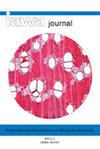Quantitative anatomy or macroscopic parameters of compression wood of Picea abies (L.) H. Karst.? Defining the optimal parameters for dendrogeomorphic purposes
IF 3.5
3区 农林科学
Q2 FORESTRY
引用次数: 0
Abstract
The quantification of the intensities of tree growth responses to the impact of geomorphic processes is a modern research trend in dendrogeomorphology. It enables a more sensitive assessment of the activity of the studied geomorphic process compared to the traditional use of growth disturbances. The advanced definitions of individual intensity classes of growth disturbances are based exclusively on macroscopic observations. This study evaluates the possibility of anatomical quantification of compression wood (CW) intensity in the case of common spruce (Picea abies (L.) Karst.) and compares it with subjective macroscopic evidence of CW with respect to stem tilting intensity. In total, 25 disturbed (tilted) individuals of P. abies occupying a landslide active during July 1997 were sampled, and 21 of them were analysed. The intensity of external disturbance (stem tilting) was compared against the macroscopic (intensity and duration) and microscopic (quantitative change of the tracheid lumen area and the cell wall proportion) parameters of compression wood suitable for practical application in common dendrogeomorphic analysis. Generally, the macroscopic indices of CW were strongly correlated with stem tilting. The intensity of the anatomical growth response was stronger in the earlywood zone than in the latewood zone. Nevertheless, their dependence on stem tilting was not detected. Results suggest that CW classification based on the quantification of anatomical changes is not possible for dendrogeomorphic purposes. Nevertheless, based on the obtained results, the present study suggests preferring the most intensively tilted trees during future dendrogeomorphic research to obtain the most intensive macroscopic and subjective observable anatomical evidence for studying compression wood.杉木压缩材的定量解剖及宏观参数h .岩溶。确定树木地貌的最佳参数
量化树木生长对地貌过程的响应强度是现代树木地貌学研究的一个趋势。与传统的使用生长干扰相比,它能够更敏感地评估所研究的地貌过程的活动。生长扰动的个别强度等级的高级定义完全基于宏观观测。本研究评估了普通云杉(Picea abies (L.))压缩木材(CW)强度的解剖学量化的可能性。喀斯特),并将其与CW的主观宏观证据在茎倾强度方面进行比较。在1997年7月活动的滑坡中,共采集了25株受干扰(倾斜)的冷杉,并对其中的21株进行了分析。将外部扰动(茎秆倾斜)强度与压缩木材宏观(强度和持续时间)和微观(管胞管腔面积和细胞壁比例的定量变化)参数进行比较,以适应普通树木地貌分析的实际应用。总体而言,茎秆倾斜程度与茎秆倾斜程度的宏观指标密切相关。早木区解剖生长响应强度大于晚木区。然而,没有检测到它们对茎倾斜的依赖。结果表明,基于解剖变化量化的连续波分类不可能用于树木地貌学目的。尽管如此,基于已获得的结果,本研究建议在未来的树木地貌研究中优先选择倾斜程度最高的树木,以获得研究压缩木材最密集的宏观和主观可观察的解剖学证据。
本文章由计算机程序翻译,如有差异,请以英文原文为准。
求助全文
约1分钟内获得全文
求助全文
来源期刊

IAWA Journal
农林科学-林学
CiteScore
3.40
自引率
15.80%
发文量
26
审稿时长
>36 weeks
期刊介绍:
The IAWA Journal is the only international periodical fully devoted to structure, function, identification and utilisation of wood and bark in trees, shrubs, lianas, palms, bamboo and herbs. Many papers are of a multidisciplinary nature, linking
 求助内容:
求助内容: 应助结果提醒方式:
应助结果提醒方式:


